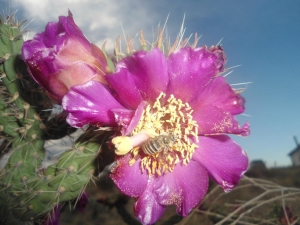What a “BEEutiful” time of year to celebrate honey bees. Noted as the most important pollinating insects in the world, honey bees may travel up to 55,000 miles while visiting more than two million flowers in order to make a single pound of honey. Brought to North America from Europe in the 1600s, honey bees are now bred commercially to produce honey, make honeycomb and of course to pollinate crops. With an annual value that exceeds $20 million dollars in pollinating alone, it is not difficult to understand how honey bees can “BEE” so important. Here in Colorado, crops such as peaches, pears, apples and melons depend on honey bees for their pollination. Honey bees are only one of approximately 20,000 species of bees.
Here in Colorado, honey bees are the only bee/wasp species that consistently overwinter as an entire colony. Mature colonies are made up of 20,000-80,000 individuals, including sterile female workers, a fertile queen and male drone (which come from unfertilized eggs). Queens mate only once and produce controlling pheromones that regulate the production of new queens among other things. Workers live an average of 5-7 weeks in the summer with the younger workers caring for the brood, building the honey comb and guarding the hive. Older workers are the ones charged with foraging to gather pollen and nectar. In order to ventilate the hive, young workers create an air current using their wings. Adult workers are ½ to 5/8 of an inch in length whereas the queen is slightly larger at 5/8 to ¾ of an inch. Colors range from an orange to brown bands with alternating black bands around the abdomen. They are covered in pale hairs giving them a fuzzy appearance. Honey bees from European stock are not aggressive, but will defend themselves as well as their hive by means of stinging if threatened or the nest disturbed. Africanized honey bees are not likely to be found in Colorado, especially in the cooler northern regions, and are much more likely to be aggressive.
In recent years, increased concern has occurred as honey bees have been experiencing complications known as colony collapse disorder in which honey bee hives are found empty. Blame for these occurrences has varied from viruses to mites to poor nutrition keeping activities to most recently the misuse or over use of certain pesticides known as neonicotinoids. Research is on-going in regards to this field in order to determine potential causes and resolutions.
